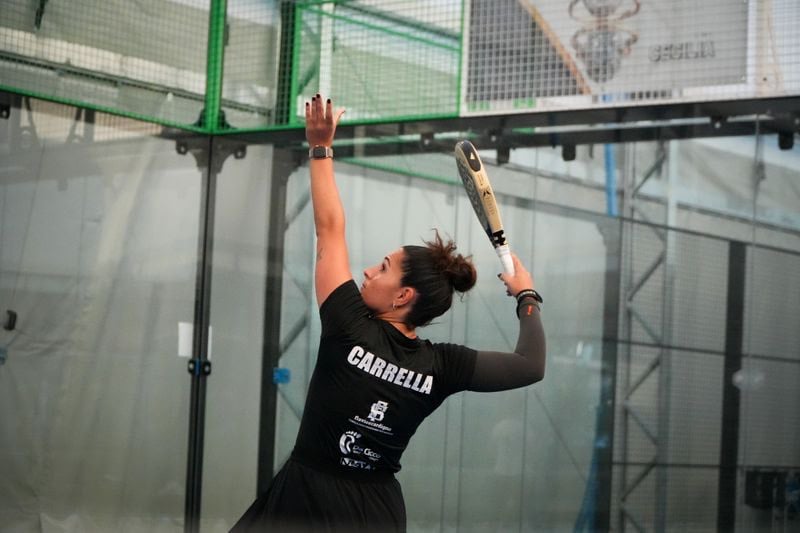Flora Carrella, a successful Italian tennis player and Coach, has moved to padel as the sport grows exponentially across the world. As a coach, Flora, rather than leaning on credentials, emphasizes adaptation to the game, to the player, and to the moment. Whether she’s guiding juniors through their first tournaments or working with seasoned pros, Carrella’s coaching is as strategic as it is personal.
“Tennis rewards individual explosiveness and technical precision,” she says. “Padel, by contrast, is about reading the game collaboratively and constructing points with tactical patience.”
Coaching Two Sports, Two Mindsets
Carrella doesn’t just coach two racquet sports—she deconstructs and refines her methods to fit each one’s demands. In tennis, she focuses on mechanics, footwork across a larger court, and the ability to generate power and spin. Particular attention goes to the serve, which she calls a “primary weapon” that can control the tone of an entire match.
In padel, the shift is clear: smaller court, enclosed space, always doubles. “It’s a different kind of intelligence,” she explains. “You have to understand the walls, anticipate rebounds, and know when to let the ball go instead of rushing it.” Instead of force, it’s positioning, anticipation, and communication that take center stage.
Building Sessions Around Decision-Making
When it comes to structuring training sessions for competitive padel players, Carrella is deliberate about balancing technical repetition with tactical readiness. Her format moves from dynamic warm-ups to technical drills to match-specific scenarios, always with progression in mind.
For instance, players might start by working on the bandeja (a classic defensive overhead), then shift into drills that simulate point-building with net pressure, followed by situational games that challenge their shot selection under tournament-style constraints.
“Everything we train is purposeful,” she says. “There’s a reason behind every drill—why we take a certain position, why we defend with a lob instead of attacking, why we reset the point instead of forcing it.”
Common Mistakes, Especially from Tennis Converts

Carrella frequently coaches players who transition from tennis to padel—and that transition isn’t always smooth.
“The biggest issue I see is players refusing to use the glass,” she notes. “In tennis, you avoid the back wall. In padel, it gives you angles, time, and opportunities. That shift in mindset is critical.”
She also sees an overreliance on topspin and raw power. While topspin adds control in tennis, it often leads to ineffective bounce or higher balls in padel. “Sometimes a low slice is ten times more useful than a heavy drive,” she says. “It’s about control, not just aggression.”
Correction comes through what she calls tactical re-education—a mix of video review, slowed-down situational drills, and pattern-based coaching that forces players to unlearn old habits.
Developing Mental Resilience, Especially in Youth
Carrella sees coaching as more than just teaching technique. Particularly for young athletes, the mental and emotional aspect of training matters just as much.
She collaborates with qualified mental coaches to help players manage anxiety, pre-match nerves, and confidence issues. Techniques like visualization, breathing routines, and post-match reflection are built into training. But the role of the coach’s voice remains central.
“Tactical clarity is one of the best antidotes to nerves,” she says. “When players understand what their real tools are—and when to use them—they stop panicking and start playing with intent.”
She encourages juniors to own their game, not just copy others. That means learning to analyze patterns, recognize tendencies, and choose their shots based on context, not impulse.
Adapting to the Individual

Whether coaching juniors, adult beginners, or experienced players, Carrella emphasizes the importance of connection. “No two players are the same. Effective coaching means meeting people where they are,” she says.
For juniors, the focus is technical foundation and psychological growth. For adults, it’s about progress within physical limits and fostering long-term enjoyment. But across all levels, she prioritizes active listening, goal-setting, and sustainable development.
“I don’t coach from a formula,” she says. “I coach from a dialogue.”
Competitive Sports as a Tool for Life
Carrella is also clear-eyed about the broader value of competitive sports, particularly for kids.
“Not every child becomes a champion. But they all become something else—more structured, more resilient, more self-aware.”
She views padel as an ideal sport for teaching cooperation and mutual respect. “It’s a doubles game. You succeed based on how well you play with someone else—not just for yourself.”
That mindset—focused on teamwork, reflection, and adaptability—is central to her coaching philosophy. “I want kids to understand that sport is a tool. It teaches you how to commit, how to handle defeat, and how to grow. Whether or not they go pro, those lessons stay with them.”

